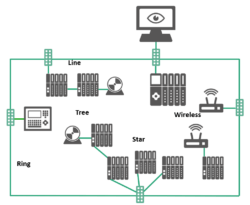Ring topologies establish media redundancy. If a wire breaks in one section of the ring, there is a secondary connection to the network. The image below shows an example of a ring topology within a network with multiple topologies.
Generally, Ethernet should not be connected in a ring without performing some sort of management. Without managing the ring, Ethernet packets can go in circles forever, using bandwidth. PROFINET offers a solution by managing ring topologies with two defined media redundancy classes: Media Redundancy Protocol (MRP) and Media Redundancy for Planned Duplication (MRPD).
PROFINET Media Redundancy Classes
MRP: To set up an MRP ring, all nodes in the ring must support MRP. Also, at least one node must support MRP manager capabilities. If the transmission link in the ring is interrupted, the ring manager immediately activates the alternative communication path. The recovery time is in the millisecond range.
MRPD: To set up an MRPD ring, all nodes in the ring must support MRPD. Also, at least one node must support MRPD manager capabilities. In an MRPD ring, all nodes also support PROFINET IRT (CC-C devices).
Each sender in an MRPD ring sends two equal frames to the receiver in opposite directions around the ring. In case of a network failure, one frame will still arrive at the receiver. Therefore, MRPD ensures non-stop connectivity with a recovery time of zero.
Summary
If you need to establish media redundancy in a section of your PROFINET network, you have two options: an MRP ring or an MRPD ring. Make a decision based on your recovery time requirement and product capabilities. Then, work with your device manufacturer to select the appropriate PROFINET components. Since the PROFINET MRP and MRPD features are optional, users must check with their device manufacturer to confirm availability.
Learn more about other PROFINET redundancy features with this free White-Paper:
-Nelly Ayllon

